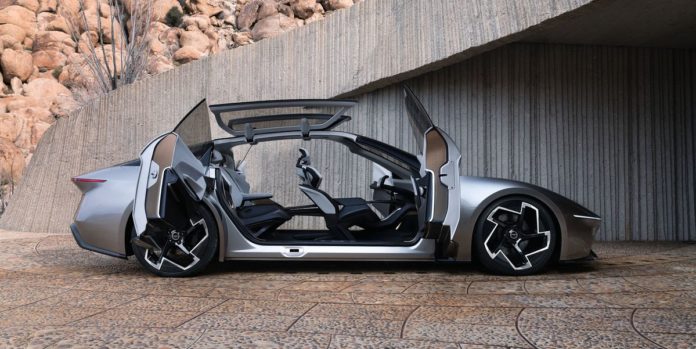When Chrysler unveiled its Halcyon Concept electric sedan on Tuesday, it noted the vehicle “incorporates 800-volt lithium-sulfur batteries,” which it said have a carbon footprint estimated at 60 percent less than today’s best batteries.
The Lyten cells it “envisions” using do not include nickel, cobalt, or manganese among their metals. Instead, they use sulfur, which is lower on the atomic table than metals used in today’s lithium-ion cells—meaning the cells are more energy-dense, i.e. they weigh less for a given energy capacity. Sulfur is also the fifth most common element on earth, found in volcanic regions and near hot springs across the globe, which could reduce its raw-materials cost.
Last May, says the release, “Stellantis Ventures, the corporate venture fund of Stellantis, announced an investment in Lyten to accelerate the commercialization of Lyten 3D Graphene applications for the mobility industry.” In other words, Stellantis invested in a company making a major component of lithium-sulfur cells. So it makes sense they’d show up in a pure concept EV that seems far from production-ready.
Regrettably, when Car and Driver reached out to Stellantis for more details, the company declined to discuss the new cells. “Thanks for reaching out, but at this time we aren’t providing additional details on this future battery technology as envisioned for the Halcyon concept,” a Chrysler/Dodge spokesperson responded.
Cell of the Future?
Lithium-sulfur cells swap in sulfur for the various mixtures of nickel, manganese, cobalt, and aluminum (collectively known as NMCA) found in most of today’s EV cells. In theory, this results in higher energy density than current cells, which translates to more EV range in less volume—and less mass. But, as of today, not a single on-road vehicle is powered by the technology.
Still, efforts to reduce or eliminate the use of rare and expensive metals have surged as EV makers look past today’s NMCA and the lower-cost but less energy-dense iron phosphate (LFP) chemistries. The goal is to use other elements—especially plentiful ones—that have the right energy-carrying properties.
For a real-world assessment of where lithium-sulfur cells stand for electric vehicles, Car and Driver reached out to Haresh Kamath, director of energy storage at the Electric Power Research Institute, known as EPRI.
We asked Kamath whether lithium-sulfur batteries were a credible alternative to today’s lithium-ion cells. They are, he said, “and have been recognized as such for 30 years—but, it’s likely to take years of steady work on the technology to [create] successful products, scalable manufacturing, and commercialization.”
Even with all those challenges met, though, “there is no guarantee commercial lithium-sulfur products will be cost-competitive with lithium-ion,” Kamath cautioned. “Mass commercialization will require us once again to address the big questions of fire and explosion hazard in a new technology that has important safety differences from lithium-ion.”
He went on: “Taking any battery technology from the lab to the field is no joke: It requires a lot of capital investment and the wherewithal to successively design, build, qualify, and scale up cells, then batteries, then systems,” Kamath continued. “This takes years. Even mature, knowledgeable, well-capitalized companies rarely hit their timelines.”
That said, “companies developing batteries today are huge operations backed by massive investment and the willingness to spend the time it takes to get there,” Kamath said. “These kinds of scale efforts by Sony and Panasonic in the 1980s resulted in the successful commercialization of the lithium-ion battery. These efforts are now being applied to solid-state batteries, silicon anodes, and others.”
But, Kamath cautioned, lithium-sulfur is not a drop-in replacement for lithium-ion. He highlighted four important points to which he feels the developers must pay close attention:
- The cell voltage is half that of a typical lithium-ion cell at full charge (2.1V/cell vs. 4.2 V/cell). This requires more cells per battery, potentially reducing energy density.
- The cycle life for lithium-sulfur has been very poor, for multiple. Several researchers say they have addressed these issues, but we have yet to see data showing these cells perform as well as lithium-ion.
- Unlike lithium-ion, lithium-sulfur exhibits side reactions which create inefficiencies during charging, which reduces charging efficiency and generates heat that must be carefully dealt with to maximize battery life.
- Lithium-sulfur contains metallic lithium, so it demands different safety approaches from lithium-ion cells of all chemistries.
Not Quite Ready
In short, lithium-sulfur remains battery chemistry in development. Like solid-state lithium-ion cells, the chemistry shows theoretical promise—but has not yet progressed to the stage that it will imminently be scaled up for mass production and use in electric vehicles. As Kamath notes, battery development takes a very long time.
That means Chrysler EVs of the late 2020s, whatever they may be, are far more likely to be powered by some variant of today’s lithium-ion cells than they are by lithium-sulfur cells.
The author has written occasional analyses of the electric-car world for the Electric Power Research Institute (EPRI), which is how he came into contact with its director of energy storage, Haresh Kamath, quoted in the piece above.
John Voelcker edited Green Car Reports for nine years, publishing more than 12,000 articles on hybrids, electric cars, and other low- and zero-emission vehicles and the energy ecosystem around them. He now covers advanced auto technologies and energy policy as a reporter and analyst. His work has appeared in print, online, and radio outlets that include Wired, Popular Science, Tech Review, IEEE Spectrum, and NPR’s “All Things Considered.” He splits his time between the Catskill Mountains and New York City and still has hopes of one day becoming an international man of mystery.

